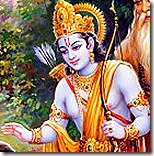 “Meditation on saguna is not very tasteful, and nirguna remains far away from the mind. Therefore, take the life-giving remedy of Shri Rama’s holy name, says Tulsi.” (Dohavali, 8 )
“Meditation on saguna is not very tasteful, and nirguna remains far away from the mind. Therefore, take the life-giving remedy of Shri Rama’s holy name, says Tulsi.” (Dohavali, 8 )saguna dhyāna ruci sarasa nahiṃ nirguna mana te dūri |
tulasī sumirahu rāmako nāma sajīvana mūri ||
As soon as there is birth, there is death. In this sense there is no reason to be too concerned with the end of life, as it is part and parcel of the ride. If we are to overly lament the exiting of the soul from the dwelling it has grown accustomed to, we might as well cry tears of pain and distress when there is a birth, for as soon as the infant exits the womb they are guaranteed to have to suffer separation at some point in time. As the essence of life within all forms of independent bodies, the soul is pure and eternal in its constitution. Yet since matter is the opposite in quality, dull and lifeless, he whose focus remains completely on the inanimate objects of this world - manifestations that are incapable of acting on their own - can be considered dead inside. When all time is spent in an intoxicated state, the addict becomes one with their habit of choice, taking on the impure nature of alcohol and drugs. In a similar manner, through exclusive association with matter and delusion fueled by plans and hopes for furthering sensual enjoyments, the soul remains trapped within the body, with its real energy, service and love depressed. One practice, however, proves most effective at unleashing the full potential for spiritual power, thus giving life to any dying man.
“For one who has taken his birth, death is certain; and for one who is dead, birth is certain. Therefore, in the unavoidable discharge of your duty, you should not lament.” (Lord Krishna, Bhagavad-gita, 2.27)
 Religion, or spirituality, exists for the benefit of the dying man, he who has assumed a material body that is destined for destruction. Since the soul is eternal, what we consider a life is actually a demarcation of time. Just as we spend a specific number of hours in school or at work on a given day, the soul spends a certain amount of time in a particular dwelling, one that constantly changes, until their time is up. If the occupant’s desires are not purified by the time of exit, they will be forced to repeat the same cycle of association in the future, with the measurement of a lifetime starting over; sort of like a resetting of the clock. The cycle can be compared to the student who has failed to understand the key concepts of his particular class or grade and is then forced to repeat the same class. Only in a bogus school system would a child be advanced to another grade without sufficient knowledge acquired. Indeed, the grade level has a meaning; it represents the minimal level of understanding of the students within that classification.
Religion, or spirituality, exists for the benefit of the dying man, he who has assumed a material body that is destined for destruction. Since the soul is eternal, what we consider a life is actually a demarcation of time. Just as we spend a specific number of hours in school or at work on a given day, the soul spends a certain amount of time in a particular dwelling, one that constantly changes, until their time is up. If the occupant’s desires are not purified by the time of exit, they will be forced to repeat the same cycle of association in the future, with the measurement of a lifetime starting over; sort of like a resetting of the clock. The cycle can be compared to the student who has failed to understand the key concepts of his particular class or grade and is then forced to repeat the same class. Only in a bogus school system would a child be advanced to another grade without sufficient knowledge acquired. Indeed, the grade level has a meaning; it represents the minimal level of understanding of the students within that classification.The soul inside of dead matter is deemed temporarily lifeless in the sense that its true potential for action, pleasure and service goes unmet. Religion seeks to not only deal with impending death, but also to find an engagement which is eternally fulfilling, one that provides the most satisfaction. Ironically enough, the panacea of spiritual life needn’t be found only in the afterlife, as the soul travelling through reincarnation is fully capable of transcending the effects of matter. Yet to break free of the animal instincts strengthened over so many lifetimes spent in the temporary realm, help is required, instruction from one who has seen the light themselves.
Though the different spiritual traditions of the world can provide prescriptions for salvation which appear to be unrelated to one another, pretty much all methods of worship can be grouped into two general categories: saguna and nirguna, or personal and impersonal. When the Supreme Lord, the ultimate object of worship, is described as being beyond the senses and lacking a perceptible form, the type of worship employed is of the nirguna variety, which means “without qualities”. This isn’t to say that God is without a form. As a person intelligent enough to create the massive universe and all of its pieces which function like clockwork, the Lord certainly cannot be void. His transcendental body is described in the Vedas as sach-chid-ananda, or eternally full of bliss and knowledge. Due to association with matter, the conditioned living entity cannot think beyond the dualities encountered on a regular basis; therefore the term “nirguna”, which comes from the Vedas, the ancient scriptures of India, very nicely describes God’s unique feature of being beyond all qualities perceived by the human eye.
“For those whose minds are attached to the unmanifested, impersonal feature of the Supreme, advancement is very troublesome. To make progress in that discipline is always difficult for those who are embodied.” (Lord Krishna, Bg. 12.5)
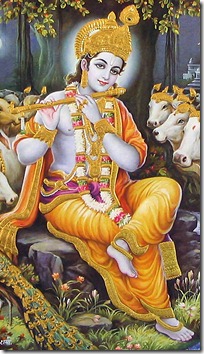 Nirguna worship doesn’t necessarily have to focus on the impersonal aspect of the Absolute Truth, which is known as Brahman in the Vedic tradition. If a supreme person is identified, whether He is addressed as God or something else, if the followed methods of worship don’t involve direct service to Him derived from knowledge of His transcendental form and features, the practices fall into the nirguna category. There is great difficulty and struggle in taking to this route of spiritual awakening. The conditioned entity is essentially tasked with understanding a being who doesn’t have a form and yet is beyond all duality and temporary manifestations of matter. Indeed, Lord Krishna, the Supreme Personality of Godhead and original form of the Absolute Truth, very accurately points out in the Bhagavad-gita that those who take to understanding the unmanifested feature of the Absolute Truth find great trouble in their path. Nirguna, when not properly understood, remains far away from the worshiper.
Nirguna worship doesn’t necessarily have to focus on the impersonal aspect of the Absolute Truth, which is known as Brahman in the Vedic tradition. If a supreme person is identified, whether He is addressed as God or something else, if the followed methods of worship don’t involve direct service to Him derived from knowledge of His transcendental form and features, the practices fall into the nirguna category. There is great difficulty and struggle in taking to this route of spiritual awakening. The conditioned entity is essentially tasked with understanding a being who doesn’t have a form and yet is beyond all duality and temporary manifestations of matter. Indeed, Lord Krishna, the Supreme Personality of Godhead and original form of the Absolute Truth, very accurately points out in the Bhagavad-gita that those who take to understanding the unmanifested feature of the Absolute Truth find great trouble in their path. Nirguna, when not properly understood, remains far away from the worshiper.The key ingredient of worship is remembrance, which is a product of consciousness. When we complete a class in school, our grades on the final exam and our production throughout the course period indicate to the instructor whether or not we are fit for advancing. For the natural acrobat known as the soul, its consciousness is measured at the time of death to give an indication to the higher authorities of where and when the next placement will occur. The dying man can continue to live in association with dead matter through a consciousness driven by material desires, or he can find endless spiritual bliss through remembrance of the Absolute Truth.
When the nirguna aspect is not properly understood, i.e. when the Absolute Truth is thought to be formless and beyond perception, purifying consciousness becomes very difficult. We have a hard time comprehending an entity who is not formed through material qualities and who doesn’t have to listen to anyone. As such, the nirguna aspect remains far away from the worshiper, for even those who claim to understand it are often misguided themselves. The most severe transgression resulting from improper understanding of the Absolute Truth is the misconception that man is himself God. If I tell you that nirguna is formless and beyond comprehension, and then I subsequently tell you that I am that very same nirguna form, what authority does the other person have to challenge my assertion? Indeed, not only is the nirguna form very difficult to understand, but it is also a ripe target for charlatans, thieves, and cheaters who try to bring about some concocted method of worship. Only when the real form of the Lord remains a mystery can practices such as philanthropy, charity, environmentalism, animal slaughter and same sex relations be mistaken for the highest occupational duty in life, or dharma.
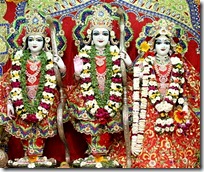 To remove the doubts of those who are unable to understand nirguna properly, and to also expose the cheaters who have boldly proclaimed to be God, the saguna form manifests from time to time on earth. Saguna is “with attributes”, but again, this doesn’t mean that God can ever associate with matter. The labels of nirguna and saguna are strictly from the perspective of the conditioned eye whose spiritual potency is in a dormant state caused by a longtime association with matter. The saguna form can be the qualified expansion of the original Personality of Godhead or the original person Himself who appears on earth and enacts pastimes. Saguna also refers to the deity representation, a marble or stone statue, or even a picture, that represents the incarnation or the original form of the Lord.
To remove the doubts of those who are unable to understand nirguna properly, and to also expose the cheaters who have boldly proclaimed to be God, the saguna form manifests from time to time on earth. Saguna is “with attributes”, but again, this doesn’t mean that God can ever associate with matter. The labels of nirguna and saguna are strictly from the perspective of the conditioned eye whose spiritual potency is in a dormant state caused by a longtime association with matter. The saguna form can be the qualified expansion of the original Personality of Godhead or the original person Himself who appears on earth and enacts pastimes. Saguna also refers to the deity representation, a marble or stone statue, or even a picture, that represents the incarnation or the original form of the Lord.Saguna worship is typically practiced in a temple or in a specific area within the house designated for prayer and worship. Though matter is dull and lifeless, when it is used to properly advance the consciousness of the individual, it becomes completely spiritual. As such, the picture or deity representation of God actually transcends all gunas for those who worship it properly. Saguna worship is far superior to nirguna worship because there is much less chance for error. The incarnation exposes all the cheaters who try to lure the innocent into worshiping them in lieu of offering obeisances to the real form of Godhead. The material world continues to remain in existence for as long as there is even one soul who desires to imitate God or challenge His abilities in the areas of creation, maintenance, destruction and enjoyment. The discrepancy in levels of attention cause the strongest jealousy, as God has been loved and adored by the most people throughout the course of human history. The cheaters who try to explain nirguna as being formless and thus bereft of intelligence are seeking to have everyone worship and idolize them. Thus they represent a direct challenge to God’s authority. Moreover, since they have failed to understand the Lord’s true position as a person with spiritual attributes, these cheaters are wholly incapable of providing any tangible benefit to their worshipers.
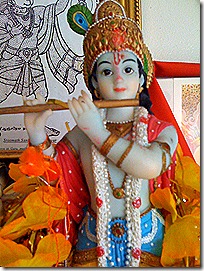 But even with strict saguna worship there are some limitations. As mentioned before, the key to spiritual enlightenment is a purification of consciousness. Surely while one looks at the deity form in the temple they can feel tremendous bliss, but the conditioned soul is accustomed to tastes of the phenomenal world, such as impure foods, intoxicating beverages, and sights of beautiful members of the opposite sex. Since especially in today’s day and age it is very difficult to meet the basic demands of the body, the majority of the time in each week is spent working for a living. As a result, during work hours activities are focused on material engagements, thus leading the eyes to look at objects which are not the saguna form. God is certainly everything, but matter is considered His separated energy; hence there is no personal presence of the Supreme Spirit within anything that is material. The hands and legs of the body are considered part of the person, but we still can’t talk to someone’s feet and expect them to hear us or respond. Similarly, worshiping dull matter through steady allegiance of action and attention doesn’t bring any advancement in consciousness.
But even with strict saguna worship there are some limitations. As mentioned before, the key to spiritual enlightenment is a purification of consciousness. Surely while one looks at the deity form in the temple they can feel tremendous bliss, but the conditioned soul is accustomed to tastes of the phenomenal world, such as impure foods, intoxicating beverages, and sights of beautiful members of the opposite sex. Since especially in today’s day and age it is very difficult to meet the basic demands of the body, the majority of the time in each week is spent working for a living. As a result, during work hours activities are focused on material engagements, thus leading the eyes to look at objects which are not the saguna form. God is certainly everything, but matter is considered His separated energy; hence there is no personal presence of the Supreme Spirit within anything that is material. The hands and legs of the body are considered part of the person, but we still can’t talk to someone’s feet and expect them to hear us or respond. Similarly, worshiping dull matter through steady allegiance of action and attention doesn’t bring any advancement in consciousness.Due to these circumstances, developing a taste for worshiping the saguna form is very difficult. So what can we do? Goswami Tulsidas very nicely provides the answer. He says that the nirguna form remains far away from the mind and that the saguna form is difficult to develop a taste for. But remembering the holy name of Lord Rama is like finding an herb that gives life to a person who is dying. The name is the most powerful incarnation of the Supreme Lord because it can automatically evoke memory of His other names, forms, pastimes and qualities. Understanding Brahman, or that which is considered nirguna, can lead to a higher level of intelligence, but since Brahman is not an object, it doesn’t have names, forms or attributes. The saguna form evokes memories of God’s transcendental features, His pastimes and qualities, but the names, which bring tremendous transcendental sweetness to the tongue, mind and ear, remain far away. It is also very difficult to develop a taste for something just by staring at it. The worshiped object’s features may be understood and remembered while in the direct presence, but the active propensity to love is not utilized fully when the worshiper is silent. In this respect the holy name is the most potent incarnation of God, as it can be meditated upon, remembered and invoked regularly, by any person, at any time and at any place.
So which name should we chant? Tulsidas especially likes the name of Rama, which describes the Lord’s ability to provide transcendental pleasure to others. Rama is also the name of the incarnation of Godhead who appeared on earth during the Treta Yuga as a handsome warrior prince. Since Tulsidas is a poet, it’s understandable if he would use hyperbole every now and then to get his point across, but his statements pertaining to the potency of remembering Rama’s name are anything but exaggerated. If we find ourselves in the most difficult circumstances, where we feel like our life is being taken away or that our time on earth is not being utilized properly, simply remembering Rama’s name can arouse spiritual stimulation from within. Who wouldn’t be elated by remembering Rama’s beautiful smile, His protection of the innocent citizens of the world with the use of His bow and arrow, His deep love and affection for Sita, Lakshmana, Hanuman and all the Vanaras in Kishkindha, His ability to kill 14,000 Rakshasas without needing any outside help, and His dedication to the truth by coming through on His promises? Lord Rama’s most sincere vow is that He will grant protection to anyone who surrenders unto Him.
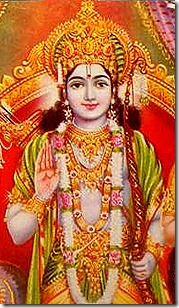 Surrender in the spiritual sense is a state of mind where the competition with God is renounced and the Supreme Lord is voluntarily handed over full control over one’s emotional well-being. The surrendered soul maintains their acknowledged inferior position through acts of devotion in what is known as the discipline of bhakti-yoga, or devotional service. Not surprisingly, the quintessential act of bhakti is chanting sacred mantras like, “Hare Krishna Hare Krishna, Krishna Krishna, Hare Hare, Hare Rama Hare Rama, Rama Rama, Hare Hare”. The Vedas declare that the benefit of chanting the name of Rama three times can be had by reciting the name of Krishna just once. Krishna means all-attractive, so it is the best word to describe the ultimate feature of the Absolute Truth. Nevertheless, for devotees of Lord Rama, the supposed deficiency in His name brings only greater justification for chanting it even more and remembering it at all times.
Surrender in the spiritual sense is a state of mind where the competition with God is renounced and the Supreme Lord is voluntarily handed over full control over one’s emotional well-being. The surrendered soul maintains their acknowledged inferior position through acts of devotion in what is known as the discipline of bhakti-yoga, or devotional service. Not surprisingly, the quintessential act of bhakti is chanting sacred mantras like, “Hare Krishna Hare Krishna, Krishna Krishna, Hare Hare, Hare Rama Hare Rama, Rama Rama, Hare Hare”. The Vedas declare that the benefit of chanting the name of Rama three times can be had by reciting the name of Krishna just once. Krishna means all-attractive, so it is the best word to describe the ultimate feature of the Absolute Truth. Nevertheless, for devotees of Lord Rama, the supposed deficiency in His name brings only greater justification for chanting it even more and remembering it at all times.The beauty of the prescription given by Tulsidas is that not only is the dying man given a life-saving herb in the form of Rama’s name, but the saguna and nirguna aspects become perfectly understood as well. In strict nirguna worship, the object of service is vaguely understood to be a beam of light, or a transcendentally situated energy. In the neophyte stage of saguna worship, the Supreme Lord is understood to exist only within the temple or wherever His personal body resides. But through steady chanting and dedication to bhakti, God’s all-pervading nature is properly understood. Not only is His original feature of Bhagavan, or the most fortunate Supreme Person, realized, so is His universal presence and His fixed position within the hearts of every living entity as the Supersoul. Only the bhakta, or devotee, can understand that both saguna and nirguna refer to the same person, the only entity worthy of our service. Not only does God’s kingdom represent the realm of eternal life, but His name, which is non-different from Him, is the spark which ignites the undying flame of devotion within the conditioned entity, who is otherwise dead inside. There is no limit to the glories of the holy name, a sound vibration which should always be remembered, through freedom and duress alike
No comments:
Post a Comment